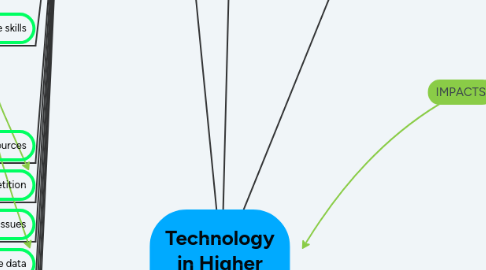
1. Challenges
1.1. Educational Inequality
1.1.1. Developing nations
1.1.2. Inaccessible areas
1.1.3. People in poverty
1.2. Digital Literacy
1.2.1. Provide students with the tools and skills to improve their digital literacy
1.2.1.1. Traditional literacy
1.2.1.2. Information literacy
1.2.1.3. Multi media literacy
1.2.2. Help students to better understand the technological environment
1.2.3. Institutions-wide support to emphasize digital literacy
1.2.4. Institutional strategic plan
1.2.4.1. Resource allocation
1.3. Changing students
1.3.1. Mature students
1.3.2. More international students
1.3.3. Digital natives
1.3.4. Working students
1.4. Disruptive technology
1.5. The issue of educational quality, accountability and effectiveness
1.5.1. Unemployment after graduation
1.5.2. Academic freedom
1.5.3. Student debt
1.5.4. Raising tuition costs
1.6. Teaching requires compressive skills
1.6.1. knowledge management
1.6.2. inter-personal communication skills, including the appropriate use of social media;
1.6.3. a range of intellectual skills
1.6.4. collaborative learning and teamwork; multi-tasking and flexibility.
1.7. Inadequate resources
1.8. Increased global and local competition
1.9. Ethical and privacy issues
1.10. Managing extensive data
1.11. Outdated Infrastructure and LMS
1.12. Knowledge obsolescence
1.13. Integrating informal and formal learning
2. Digital learning environment
2.1. Enhance teaching and learning
2.1.1. Prepare global citizenry for better future
2.1.2. Equip students with employable skills
2.1.3. Enhance student leaning experience
2.1.4. Improve communication and collaboration
2.1.5. Improve accessibility and bridge education gaps
2.2. Supporting instructors
2.2.1. Learning technology support
2.2.2. Conditions of employment
2.2.2.1. On-going mandatory training and professional development
2.2.3. Institutions strategy
2.2.3.1. Promotion and recognition
2.2.3.2. faculty development with learning technology support
2.2.3.3. Mentoring
2.2.4. A system wide approach
2.2.4.1. Recognize the need
2.2.4.1.1. Teacher education curriculum
2.3. Enabling learning tools
2.3.1. Learning management system LMS
2.3.1.1. Record keeping
2.3.1.2. Planning for Student Learning
2.3.1.3. Instruction for Student Learning
2.3.1.4. Assessment for (and of) Student Learning
2.3.1.5. Presenting authentic tasks
2.3.1.6. Providing immediate feedback
2.3.1.7. Must serve student needs
2.3.1.7.1. Enable student-student, student teacher interactions
2.3.1.7.2. Provide real time, immediate feedback
2.3.1.7.3. Personalized approaches
2.3.1.7.4. Learning focused
2.3.1.7.5. Active learning
2.3.2. Using social media for teaching and learning
2.3.2.1. Challenges
2.3.2.1.1. Compliance on disability
2.3.2.1.2. Copy right law
2.3.2.1.3. Intellectual property right
2.3.2.1.4. Privacy law
2.3.2.2. Can provide customized learning experience
2.3.2.3. Promotes engagement
2.3.2.4. Can be tailored for individual learning styles
3. Trends
3.1. The growth of a knowledge economy
3.1.1. Society has a demand for higher levels of education
3.1.2. People require new skills for successful careers
3.2. Emerging teaching learning models
3.2.1. Blended Learning
3.2.1.1. The Flipped Classroom
3.2.1.2. Hybrid or flexible learning
3.2.2. Mobile Learning
3.2.3. Fully Online Learning
3.2.3.1. Open learning
3.2.3.1.1. MOOC
3.2.4. Class Learning
3.2.4.1. Magic of the campus
3.2.4.1.1. Social interaction
3.3. Power change
3.3.1. End to "Ivory" tower" universities
3.3.2. Student's voice
3.3.3. Crowd·sourc·ing
3.4. Changing student population
3.5. Ed -tech start ups
3.6. Advancing cultures of innovation
3.6.1. Collaborative learning
3.6.2. Flexibility
3.7. Growing focus on measuring learning
3.7.1. Academic readiness
3.7.2. Assessment tool s
3.8. Redesigning learning spaces
3.9. Learning Analytics
3.9.1. statistical evaluation
3.9.2. identify patterns
3.9.3. predict future events
3.9.3.1. students connected from the network
3.9.3.1.1. retention
3.9.3.2. students disconnected from the network
3.9.3.2.1. dropouts
3.9.4. Improves learning and education
3.9.5. Processes
3.9.5.1. Knowledge continuum
3.9.5.2. Web analytics objectives.
3.9.5.3. Steps of analytics
3.9.5.3.1. Information gathering
3.9.5.3.2. information processing
3.9.5.3.3. information presentation
3.10. Enabling technologies
3.10.1. Artificial intelligence
3.10.2. Innovative apps
3.10.2.1. speech -to speech, text to -speech translation
3.10.3. Wireless power
4. Technology in HE at Institutional level
4.1. Strategic planning
4.1.1. Aligns institutional goal with technology initiatives
4.1.1.1. Know your students needs
4.1.1.2. Know your capacity
4.1.1.2.1. Financial Resources
4.1.1.2.2. Human resources
4.1.1.2.3. Technological resources
4.1.1.2.4. Space
4.1.1.3. Know your program offerings
4.1.2. Opportunities: If technology is leveraged effectively
4.1.2.1. Enhance student learning
4.1.2.2. Increase enrolment
4.1.2.3. Enhance student engagement
4.1.2.4. Motivate and engage faculty and staff
4.1.2.5. Reduce cost
4.1.2.6. Decrease/ prevent drop outs
4.1.2.7. Competitive advantage
4.1.2.8. Determine student needs
4.1.2.9. Improve communication and collaboration to meet overall institutional goal
4.1.3. Risks: if technological initiatives are not fully considered
4.1.3.1. Discourage student success
4.1.3.2. Financial risks
4.1.3.3. Staff dissatisfaction, high employee turnover
4.1.3.4. Prevent culture of innovation
4.1.4. Institutional/corporate social responsibility
4.1.5. Infrastructure
4.2. Stakeholders
4.2.1. Students
4.2.2. Government
4.2.3. Policy Makers
4.2.4. Institutions
4.2.5. Course Developers
4.2.6. Local Employers
4.2.7. Employees and Faculties
4.2.8. Ed-tech Start ups
4.2.9. International Competitors
5. Equally beneficial depending on the students
6. Leadership
6.1. Systems thinking
6.1.1. Looking at the bigger picture
6.1.2. Establish common ground
6.1.3. Social and environmental responsibility
6.1.3.1. Long term impact
6.1.3.2. Short term impact
6.2. Organizational culture
6.2.1. Change management
6.2.2. Risk management
6.3. Skills
6.3.1. Team building
6.3.2. Problem solving
6.3.3. Critical thinking
6.3.4. Informed decisions making

